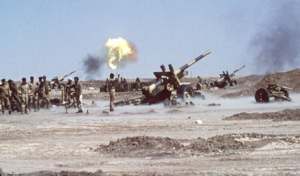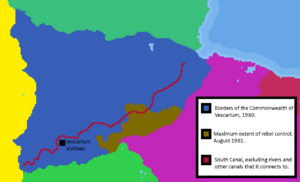South Canal Crisis
| South Canal Crisis | |||||||
|---|---|---|---|---|---|---|---|
 Rebel artillery shelling Vescarian positions near the South Canal, July 1981. | |||||||
| |||||||
| Belligerents | |||||||
| Commonwealth of Vescarium |
Free Army of Vescarium Pomaz's Mutiny | ||||||
| Commanders and leaders | |||||||
|
Cornelius Trajanus † Laurențiu Viteazu Gaius Miloslavus Sternacius Cicero (After August 3) |
Aszod Pomaz Claudius Aurelius Viorica Mureșanu Sternacius Cicero (Before August 3) | ||||||
| Units involved | |||||||
| Vescarian Armed Forces |
Free Army of Vescarium Pomaz's Mutiny | ||||||
| Strength | |||||||
| 14,950 personnel |
8,200 soldiers 4,000 militiamen | ||||||
| Casualties and losses | |||||||
|
1,040 killed 165 wounded |
3,730 killed 270 wounded 3,291 captured | ||||||
The South Canal Crisis was a short-lived military mutiny turned open revolution that occurred within Vescarium in 1981. When hardline Syndicalist Aszod Pomaz was granted control of the 19th and 25th Infantry Brigades of the Vescarian Armed Forces in January of 1981, he conspired with his ideological colleague Claudius Aurelius, who was in control of the 9th Artillery Brigade, to overthrow the government by capturing the vital South Canal waterway, which provided fresh water to the capital city of Vescarium Vurbaes. They were also joined by the Free Army of Vescarium, an agrarian-collectivist splinter group of the Syndicalist Union of Vescarium, who offered to provide extra manpower for the inevitable uprising. When the Crisis began in April of 1981, the Vescarian army was taken by surprise, and hastily scrambled to retaliate. Their initial counteroffensives failed due to incredibly poor organization and suicidal tactics. However, as the weeks passed, the Vescarian army began to slowly learn from it's mistakes, and by the end of July it was clear that the revolt would inevitably fail. Sternacius Cicero, one of the commanders of the Free Army of Vescarium, defected to the government on August 3, signalling the beginning of the end for the revolution. The Crisis would not end until October, when Pomaz himself was captured by PRI agents, causing his army to collapse and offer unconditional surrender on October 24.
